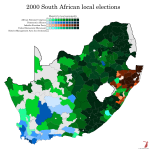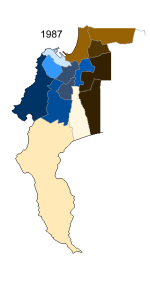The first local elections held under universal suffrage in South Africa were in November 1995, although boundary disputes saw polling delayed for six months in KwaZulu-Natal and the Western Cape. I've not been able to map these as they were held on transitional boundaries that saw many of the old local bodies continue to exist until it could be decided what was to be done with them. Well, by the next elections in 2000, they had mostly figured it out, and only one transitional body - that of the all-white intentional community of Orania in the Northern Cape - kept existing after these elections.
The system settled on was largely two-tiered, with 53
district (Category C)
municipalities and just over two hundred
local (Category B)
municipalities covering most small towns and rural areas, while the six biggest urban areas (Pretoria, Johannesburg, the East Rand (Ekurhuleni), Cape Town, Port Elizabeth and Durban) received
metropolitan (Category A)
municipalities that would exercise all local government powers over them. All local and metropolitan municipalities have a council elected by MMP, with half the seats elected in single-member wards and the other half drawn from party lists to ensure overall proportionality. This was seen as a suitable compromise between representation for ethnic and political minority groups on the one hand and the long tradition of local community representation in local government on the other. District councils function somewhat similarly, but only the proportional element is elected directly, with the other half of the seats drawn from the membership of local councils within the district.
At this point in time, not all of South Africa was included in a local municipality. Significant chunks of land, mainly national parks but also some sparsely populated rural areas (especially in the Cape provinces), were established as District Management Areas (DMAs), in which the district council would provide services directly. None of these had more than a few thousand people in them, but they were in fact still inhabited and their inhabitants did have the right to vote for the district councils. I've been unable to find results for the district council elections - and indeed separate ward and PR results for the local municipalities, I believe the ECSA's website lumps them together - and so the DMAs are shown in light grey on this map.
The first elections to these new bodies, as mentioned before, were held in December 2000. This is right in the middle of the "Peak ANC" era - Nelson Mandela had just left office, the opposition was in shambles, and everyone was still too caught up by the victory over apartheid to worry about how the ANC were actually doing in government. In the general elections held the previous year, the party got 66.3% of the vote, an absolutely insane share in a multi-party democracy, and no other party hit 10%. In the local elections, the ANC would get a relatively paltry 59%, but they still won overall majorities in 162 municipalities and were virtually unopposed across Limpopo, Mpumalanga and large swathes of the North West, the Eastern Cape and the Free State.
The 2000 local elections were also the first outing for the newly-formed Democratic Alliance, a merger of the old Democratic Party, which had formed the liberal opposition in the apartheid-era parliament, and the New National Party, the successors to the (relatively liberal faction of the) governing National Party. The NNP would pull out of the coalition in 2001, but after it entered coalition with the ANC and promptly collapsed, most of its voters went to the DA anyway. It's quite hard to compare voteshares between 1995 and 2000 given how different the electoral systems and structures were, but in raw percentage terms the DA managed to just about match the result of its predecessors, which must be considered a good performance given the DP's weakness in 1995. They won pluralities across 18 councils, mainly in the Western Cape, and won overall control of twelve councils including the Cape Town metro.
The other major forces in this election were both descended from former bantustan governments. The more successful of these by quite far was the Inkatha Freedom Party, which is named for the iNkatha, the grass crown of the old Zulu Empire. The party had been founded by Mangosuthu Buthelezi, the hereditary chief advisor to the Zulu king, to bolster his authoritarian rule over the bantustan of KwaZulu. It quickly became the single largest political movement among the Zulu population, beating out even the ANC, but its role as a support organisation for the bantustan government made it - and Buthelezi personally, it's quite hard to draw a distinction between him and the party - deeply controversial then and now. It organised Zulu resistance against apartheid through the 1980s and early 90s, bringing it into conflict with the more pluralistic ANC on a number of occasions, and when apartheid ended it carried on as a party supporting federalism, official recognition of traditional African (and especially Zulu) leadership structures, and a stricter criminal justice system. It's unquestionably a conservative party, but it denies being right-wing, citing its middle-of-the-road economic policy in particular, and at this point it was in coalition with the ANC at the national level, with Buthelezi serving as Home Affairs Minister.
The only other party to win a plurality in any council was the United Democratic Movement, founded by former Defence Minister Roelf Meyer and General Bantu Holomisa, who had been military dictator of the Transkei bantustan from 1987 to 1994. Transkei was quite possibly the weirdest bantustan - it was the biggest one to have any kind of territorial integrity, and this made it a little bit less dependent on South Africa than the other ones. As a result, its leadership frequently clashed with Pretoria, including one point in the late 70s where Transkei broke diplomatic relations with South Africa. During Holomisa's leadership, the state became a safe haven for the ANC, and he came out slightly less tainted than most of the other bantustan leaders as a result. He was nevertheless forced out of the ANC in 1996 after accusing a fellow party member of corruption in front of the Truth and Reconciliation Commission, and founded the UDM as a new multiracial party that could break through the divisions of post-apartheid South Africa. They did reasonably well in the 1999 general election, winning about 4% of the vote, but then entered a long period of decline - the one council they won control of, the King Sabata Dalindyebo municipality in the heart of the former Transkei, was lost at the next election, and although Holomisa is still an MP, he's had fewer and fewer colleagues with each successive election.
View attachment 72980




